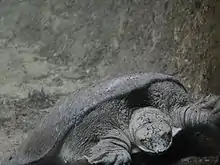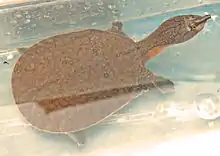Indian flapshell turtle
The Indian flapshell turtle (Lissemys punctata) is a freshwater species of turtle found in South Asia. The "flap-shelled" name stems from the presence of femoral flaps located on the plastron. These flaps of skin cover the limbs when they retract into the shell. It is unclear what protection the flaps offer against predators.[2] Indian flapshell turtles are widespread and common in the South Asian provinces. Exploitation for profit and habitat change are threats to their survival.
| Indian flapshell turtle | |
|---|---|
 | |
| Lissemys punctata andersoni | |
| Scientific classification | |
| Kingdom: | Animalia |
| Phylum: | Chordata |
| Class: | Reptilia |
| Order: | Testudines |
| Suborder: | Cryptodira |
| Family: | Trionychidae |
| Genus: | Lissemys |
| Species: | L. punctata |
| Binomial name | |
| Lissemys punctata (Lacépède, 1788) | |
| Subspecies | |
| |
| Synonyms[1] | |
| |
Description
The carapace of L. punctata viewed from above is broadly oval in adults, but more circular in young, widest just anterior to hind limbs. The width of the disc is 77-86% of its length, the carapace is moderately arched, shell height is 35.0-40.5% of carapace length, the margin of the carapace is smooth and slightly flared posteriorly, the marginal bones are not united with the pleurals, the plastron is large but mostly cartilaginous, and its length is 88-97% of the carapace length. A pair of large flaps can be closed over the hind limbs and a smaller flap over tail; seven plastral callosities are present, and the head is large, its width is 21-25% of the carapace width. The nose is short and stout; the nasal septum has no lateral ridge, the edges of the jaws are smooth, the alveolar surfaces are expanded and granular. The claws are large and heavy; the penis is thick and oval, with deep dorsal cleft and four pointed, soft papillae; the tail is very short in both sexes.[3]

The carapace length of L. punctata has been known to range from 240 to 370 mm (9.4 to 14.6 in).[4][5]
Status
The Indian flapshell turtle was placed in Appendix II of CITES in 1975 at the request of Bangladesh. However, L. p. punctata was the taxon listed, not L. p. andersoni. Subsequent reviews of the literature and available data could find no evidence to support this endangered status. Some scientists now classify L. p. punctata and L. p. andersoni as a single subspecies. This subspecies is the most common aquatic turtle in India. Consequently, the Indian flapshell turtle was removed from the endangered species list in 1983 (48 FR 52740). This action, however, did not affect the turtle's status on Appendix II of CITES.[6]
Distribution
The Indian flapshell turtle is found in Pakistan, India (common in lakes and rivers), Sri Lanka, Nepal, Bangladesh (Indus and Ganges drainages), and Myanmar (Irrawaddy and Salween Rivers). It has been introduced to the Andaman and Nicobar Islands. It is also found in the desert ponds of Rajasthan, where hundreds are killed every year during the dry summers. The race L. p. andersoni is found in Bangladesh, India, Nepal, and Pakistan. In 2020 a farmer found a yellow flapshell turtle, believed to be an albino version of the species.[7]
Fossils of this species from as early as the Miocene are known from Nepal.[8]
Type locality: "Des grandes Indes" (= continental India); restricted to "Pondicherry, Coromandel Coast, India" (11° 56'N; 79° 53'E, on the southeast coast of India) by Webb (1980).[9][10]
 Head and front legs
Head and front legs Underside showing the flaps
Underside showing the flaps Upperside
Upperside

_Indian_flap_shell_Turtle_02.JPG.webp)
 With yellow spots & blotches at Sulthanpur National Park
With yellow spots & blotches at Sulthanpur National Park Sun basking at Sulthanpur National Park
Sun basking at Sulthanpur National Park
Habitat and ecology
Food
The Indian flapshell turtle is known to be omnivorous. Its diet consists of frogs, fishes, shrimp, snails, aquatic vegetation, plant leaves, flowers, fruits, grasses, and seeds.[4]
Habitat and environmental impact
L. punctata lives in the shallow, quiet, often stagnant waters of rivers, streams, marshes, ponds, lakes and irrigation canals, and tanks. Waters with sand or mud bottoms are preferred[11] because of the turtle's tendency to burrow.[4] L. punctata turtle plays an important role to reduce pollution in aquatic ecosystems by feeding on snails, insects, and fragments of dead animals.[12]
Drought survival
L. punctata is very well adapted, both morphologically and behaviorally, to drought conditions. The turtle uses mainly burrowing and moving from water hole to water hole to avoid desiccation. The femoral flaps that cover the retracted legs help the turtle survive dry conditions. During a time of drought, the turtles enter a time of estivation in an attempt to survive the dry conditions.[13] Although many turtles die during drought conditions, some turtles have been reported to survive up to 160 days.[4][13]
Reproduction
Courtship routines
L. punctata becomes reproductively active at age 2 or 3. Courtship and mating behavior is unique. Courtship begins when the male begins stroking the female's carapace with his neck and limbs extended. When receptive, the female faces the male with her neck extended and they begin bobbing their heads vertically three or four times. This behavior is repeated, then mating begins when the female settles to the bottom and is mounted by the male. Near the end of mating, the male releases his grip and rotates to face the opposite direction from her. They remain attached in this position for as long as 15 minutes. During this time, the female may drag the male about. The pair then separates and copulation ends.[5]
Nesting
Nesting times of L. punctata occur during many periods in the year depending on habitat and location. Generally starts during the late summer to the monsoon season which is around June to November.[14] Swampy areas with soil and exposure to sunlight are common nesting sites. Eggs are usually laid two or three times per year in clutches of two to 16. These eggs are buried in soil for protection.[5]
Specific dangers and threats to species survival
Economic and environmental factors
In many South Asian provinces, freshwater turtles and their eggs are commonly used as a source of food. As a result, these turtles are often exploited as a source of profit. In Bangladesh and India, this is especially evident as the Indian flapshell turtle is larger and has more meat than other turtles in the area. The value of this meat along with the efforts in the conservation of this species has driven the price of meat higher and has led to an increase in the illegal international exploitation and killing of these animals.[15] Changes to the turtle's natural habitat by the construction of dams and barrages, cultivation along river banks, and pollution are also major threats to the survival of this turtle.[4]
Fake belief about medicinal value
The shell of L. punctata is believed to have many medicinal uses, but there is no scientific proof of such. Basically it is a myth that helps smugglers to sell them, which is an illegal activity.
References
- Fritz, Uwe; Havaš, Peter (2007). "Checklist of Chelonians of the World" (PDF). Vertebrate Zoology. 57 (2): 315–316. Archived from the original (PDF) on 17 December 2010. Retrieved 29 May 2012.
- Franklin, Carl (2007). Turtles: An Extraordinary Natural History 245 Million Years in the Making. Voyageur Press. pp. 134-136.
- Minton SA Jr (1966). "A contribution to the herpetology of West Pakistan". Bulletin of the American Museum of Natural History. 134 (2): 27-184.
- Environmental Information System (ENVIS) center of India. Zoological survey of India. Lissemys punctata. "Archived copy". Archived from the original on 2010-10-29. Retrieved 2010-12-03.CS1 maint: archived copy as title (link)
- Ernst C, Altenburg R, Barbour R (1997). Turtles of the World. Netherlands Biodiversity Information Facility. "Archived copy". Archived from the original on 2011-03-20. Retrieved 2010-12-03.CS1 maint: archived copy as title (link)
- CRS Report for Congress.98-32:Endangered Species List Revisions:A Summary of Delisting and Downlisting (cont'd)Status Archived 2006-05-13 at the Wayback Machine
- Rare yellow turtle found by farmer - CNN Video, retrieved 2020-07-27
- "Fossilworks: Lissemys punctata". fossilworks.org. Retrieved 2019-04-26.
- Webb RG (1980). "Gray, Hardwicke, Buchanan-Hamilton, and drawings of Indian softshell turtles (Family Trionychidae)". Amphibia-Reptilia 1: 61-74.
- Webb RG (1980). "The identity of Testudo punctata Lacépède, 1788 (Testudines, Trionychidae)". Bulletin du Muséum National d'Histoire Naturelle, Paris, Fourth Series 2: 547-557.
- Ernst CH, Altenburg RGM, Barbour RW (1997). Turtles of the World. Indian flapshell turtle Archived 2011-03-20 at the Wayback Machine
- Hossain L, Sarker S, Sarker N (2008). "Ecology of spotted flapshell turtle, Lissemys punctata (Lacepede, 1788) in Bangladesh". Department of Zoology, University of Dhaka. ECOPRINT. 15: 59-67.
- Auffenberg W (1981). "Behavior of Lissemys punctata in a drying lake in Rajasthan, India". Bombay 78 (3): 487-493.
- Bhupathy, S; Webb, Robert; Praschag, Peter (20 February 2014). "Lissemys Punctata (Bonnaterre 1789) - Indian Flapshell Turtle" (PDF). Chelonian Research Monographs Conservation Biology of Freshwater Turtle and Tortoises. Retrieved 18 October 2019.
- Moll D, Moll E (2004). The Ecology, Exploitation, and Conservation of River Turtles. Oxford University Press. pp. 177-180.
Further reading
- Das I (2002). Snakes and other Reptiles of India. Sanibel Island, Florida: Ralph Curtis Books. 144 pp. ISBN 0-88359-056-5. (Lissemys punctata, p. 139).
- Khan MZ, Safi A, Fatima F, Hashmi MUA, Hussain B, Siddiqui S, Khan SI, Ghalib SA (2015). "An evaluation of distribution, status and abundance of freshwater turtles in the selected areas of Sindh and Khyber Pakhtunkhwa provinces of Pakistan". Canadian Journal of Pure and Applied Sciences 9 (1): 3201–3219. http://www.cjpas.net
- Safi A, Khan MZ (2014). "Distribution and current population of freshwater turtles of District Charsadda of Khyber Pakhtunkhwa, Pakistan". Journal of Zoology Studies 1 (4): 31–38. http://www.journalofzoology.com
- Akbar M, Mushtaq-ul-Hassan M, u-Nisa Z (2006). "Distribution of Freshwater Turtles in Punjab, Pakistan". CJES 4 (4): 142–146.
- Asian Turtle Trade Working Group (2000). "Lissemys punctata". IUCN Red List of Threatened Species. 2000: e.T46579A97399871. doi:10.2305/IUCN.UK.2000.RLTS.T46579A11061187.en.{{cite iucn}}: error: |doi= / |page= mismatch (help)
- Biswas S, Bhowmik HK (1984). "Range of Lissemys punctata punctata from the foot-hills of Siwaliks". Hamadryad 9 (2): 10.
- Lacepède BGE (1788). Histoire Naturelle des Quadrupe des Ovipares et des Serpens. Vol.1. Paris: Imprimerie du Roi, Hôtel de Thou. xvii + 651 pp.
- Verma, Anil K.; Sahi, D.N. (1998). "Status, range extension and ecological notes on Indo-Gangetic flapshell turtle, Lissemys punctata andersoni (Testudines: Trionychidae) in Jammu Shiwaliks, J&K State". Cobra 34 (Oct.-Dec.): 6–9.
- Webb RG (1982). "Taxonomic notes concerning the trionychid turtle Lissemys punctata (Lacepede)". Amphibia-Reptilia (Wiesbaden) 3 (2–3): 179–184.
External links
| Wikimedia Commons has media related to Lissemys punctata. |

